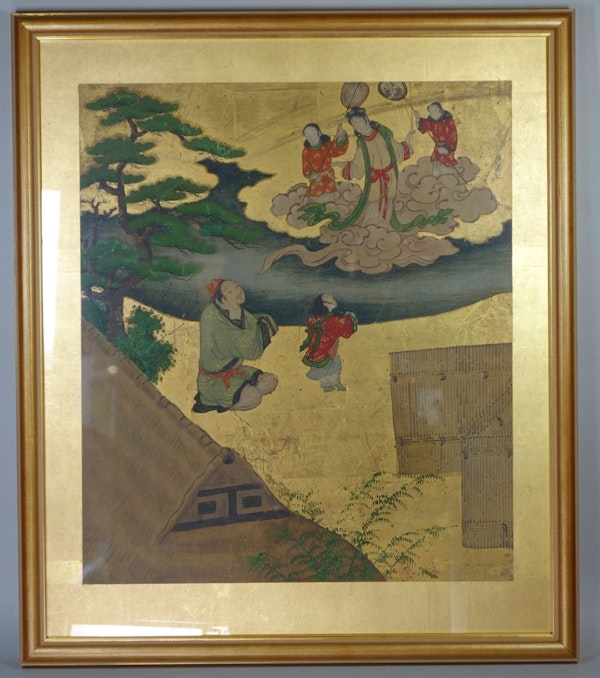Japanese Kano school painting, 17th century
Japanese Kano school painting, 17th century
POA
Description
Japanese Kano school painting, 17th century, in ink against a gold leaf background, depicting Dong Yong, kneeling beside a small child gazing up at the Heavenly Weaver, who is sailing away with her attendants on a cloud, all within a landsacape with a river, pine, thatched dwelling and bamboo screens.
Notes:
The themes and styles of Chinese art have had a signifiant influence on Japanese painting for hundreds of years, with genres including bird and flower studies, Buddhist religious paintings, inkwash landscapes, and, as seen here, depictions of traditional Confucian tales proving especially popular in medieval and early modern Japan. Despite thematic and stylistic similarities to Chinese models, Japanese paintings display a distinctly Japanese aesthetic. Mirroring this wider narrative of influence and innovation, the Kano school of painters, founded by Kano Masanobu in the 15th century, initially adhered closely to Chinese models, contributing to a revival of Chinese influence within Japanese medieval culture. However, over time the school developed a bolder, more distinctive style with firm outlines and brighter colours, as seen in this example. The Chinese text Quan xiang ershisi xiao shi xuan 全相二十孝詩選 (Selected verses on all aspects of the twenty-four filial exemplars) was compiled in the fourteenth century by the Yuan dynasty Confucian scholar Guo Jujing. The compilation of tales outlining the central Confucian concept of loyalty towards ones parents proved extremely influential across Asia and was translated into Japanese as Nijushiko 二十四孝 in the fifteenth or sixteenth century as well as becoming a popular theme in Japanese art. The tale depicted in this painting is mai shen zang fu, 卖身葬父 (He Sold Himself for His Father's Funeral), which tells the story of a man named Dong Yong, who lived alone with his father after his mother died. His father died soon after, and as Dong Yong could not afford to give his father a funeral, he sold himself into slavery. One day he married a poor woman, who helped him to weave hundreds of rolls of silk in a mere month, the sale of which enabled Dong to buy back his freedom. At this point, the woman revealed herself to be the daughter of the Heavenly Emperor, sent to aid him in his hour of need. The scene depicted here is the Heavenly Weaver bidding Dong Yong farewell and returning to the realms above, having completed her task.
| item details | |
|---|---|
| Material and Technique | Ink and gold leaf |
| Origin | Japanese |
| Period | 17th Century |
| Dimensions | Dimensions of frame: 40cm. x 46.4cm. (15 3/4in. x 18 1/4in.) |
Product REF: Q707E


